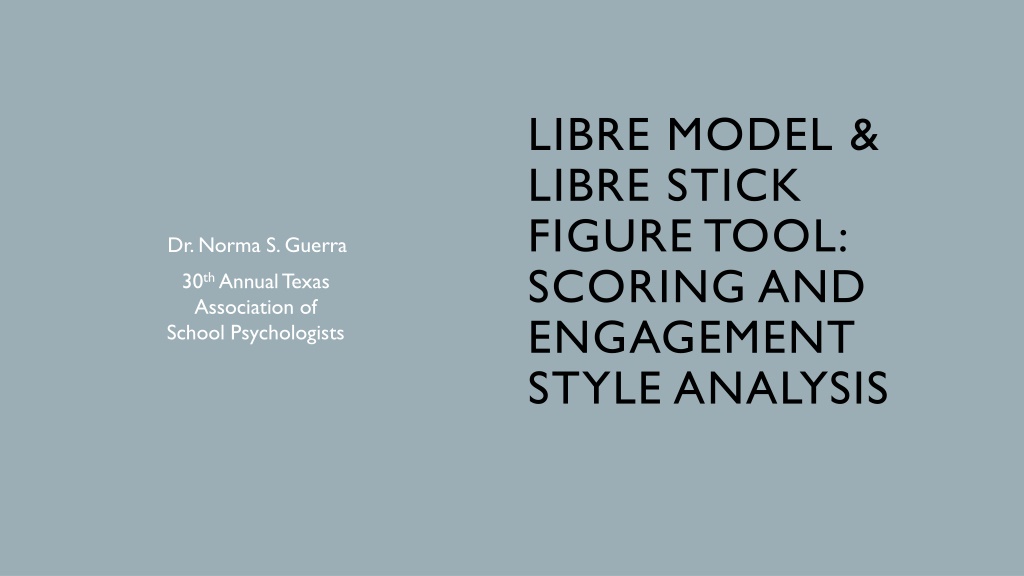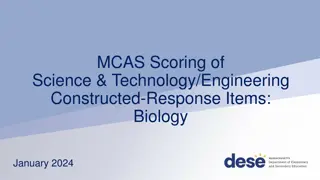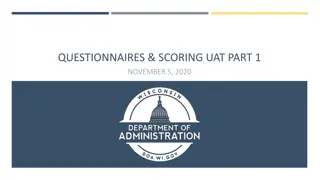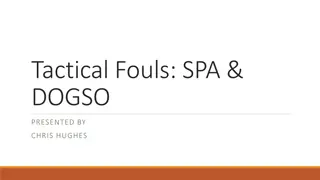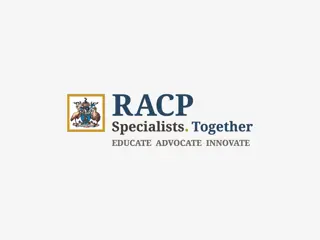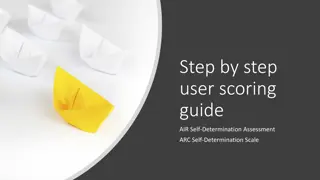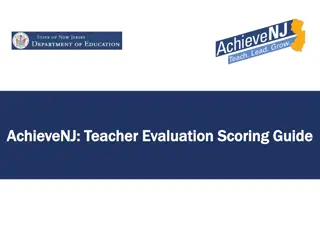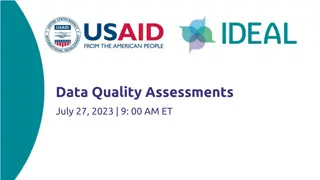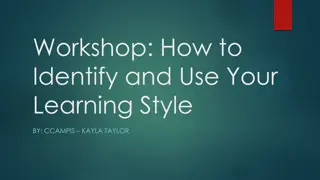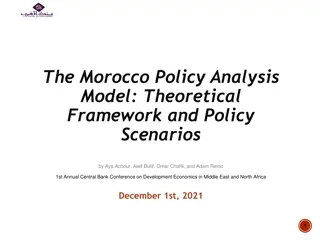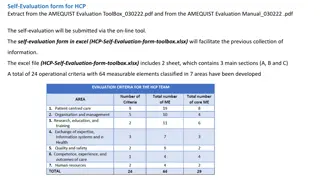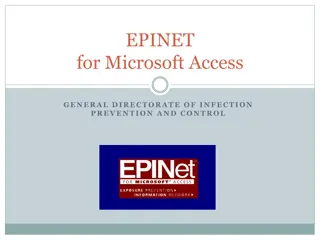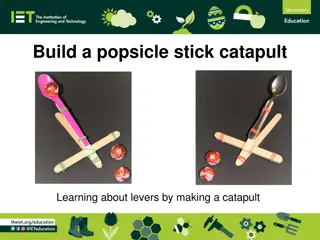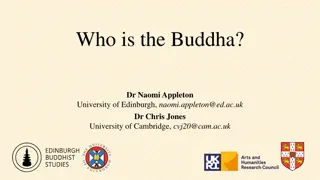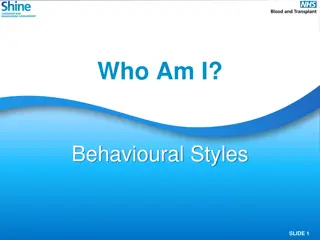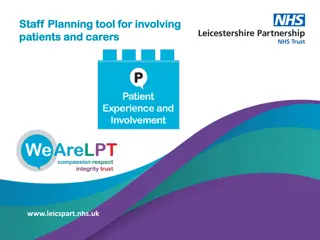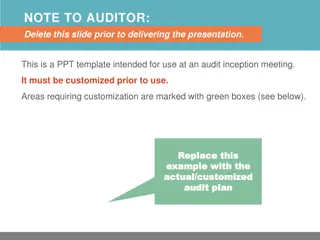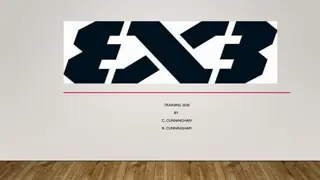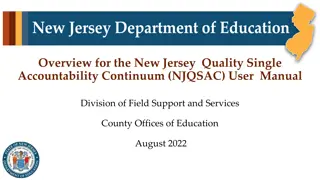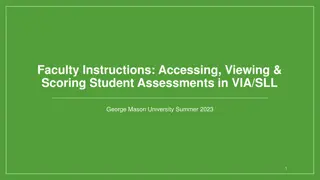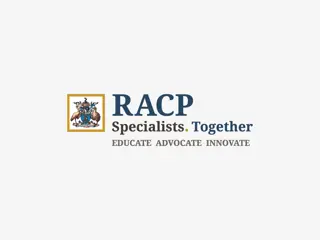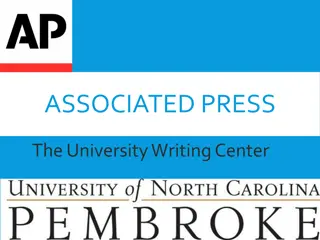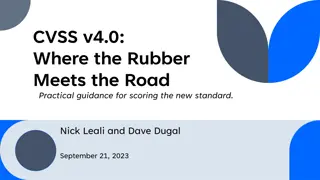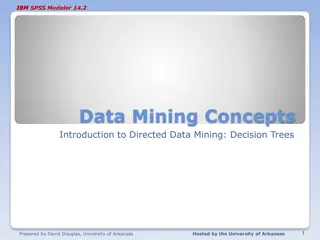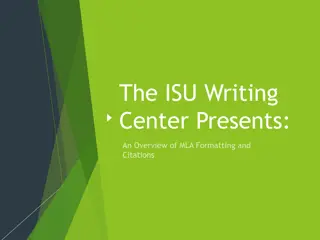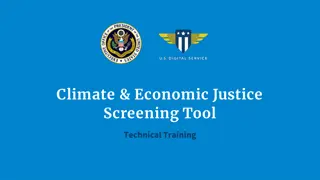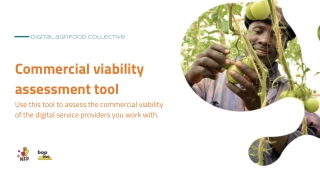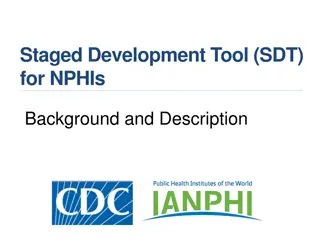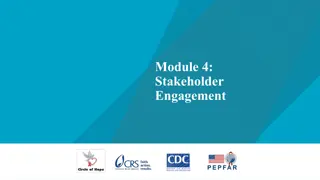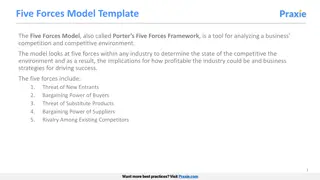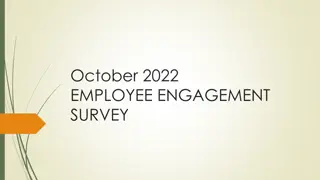Understanding the LIBRE Model Stick Figure Tool for Scoring and Engagement Style Analysis
The LIBRE Model Stick Figure Tool is designed for problem-solving exchanges between a problem-solver and a facilitator. It involves five prompts - Listen, Identify, Brainstorm, Reality-test, and Encourage - aimed at self-reflection and behavior modification. The model emphasizes self-regulated attentiveness and problem management through active participation and a structured process. Facilitators guide problem-solvers through stages like identifying concerns, exploring solutions, and setting timelines for action steps.
Download Presentation

Please find below an Image/Link to download the presentation.
The content on the website is provided AS IS for your information and personal use only. It may not be sold, licensed, or shared on other websites without obtaining consent from the author. Download presentation by click this link. If you encounter any issues during the download, it is possible that the publisher has removed the file from their server.
E N D
Presentation Transcript
LIBRE MODEL & LIBRE STICK FIGURE TOOL: SCORING AND ENGAGEMENT STYLE ANALYSIS Dr. Norma S. Guerra 30thAnnual Texas Association of School Psychologists
To provide an overview of the LIBRE Model How does the LIBRE Model work? TRAINING OBJECTIVES To introduce the participants to the LIBRE Model Stick Figure Tool (LMSFT) Ground rules and instruct provided in the application of the LMSFT LMSFT application
HOW DOES THE LIBRE MODEL WORK? The LIBRE Model is a problem-solving self-motivated exchange between a problem-solver (PS) and a facilitator. The LIBRE Model exchange consists of five prompts; the first letter of each results in an acronym for L-listen and list, I- identify a concern, B-brainstorm, R-reality-test, and E-encourage, giving the model its name. It encourages active participation with a structured five-step process to examine and with self-reflection modify behavior. Central to the LIBRE model is a focus on self-regulated attentiveness and problem management. Introduces the opportunity for self-reporting and monitoring.
LIBRE steps What is your prompt with this stage? What will happen within this stage? Let's talk about what is going on with you. I will list/record everything you tell me. What concerns are you experiencing; what is going on (with you)? Facilitator prompts the problem-solver (PS) with the question and then records the PS's response. This information is written on the 'hair' of the LIBRE Model Stick Figure Tool (LMSFT). Listen Of everything you have identified as concerns, which one would you like for us to explore during this time together? If you made that concern a question what is the question? PS identifies one concern and develops a question. For example, "What can I do to handle my stress?". Facilitator records the question on the "shoulders" of the LMSFT. Identify In response to the question you identified, list all possible solutions you can think of making sure that you say everything that you think of whether it is realistic or unrealistic. Facilitator offers open-ended questions to encourage the PS's exploration of options for addressing the identified concern. This listing is written on the left side of the LMSFT. Brainstorm Let's now eliminate all nonworking options by crossing them out. Of those remaining, if you did complete this action, what would it look like? Facilitator works with the PS in exploring consequences (positive and negative) involved in pursuing each option. The responses to: "what it would look like if the option was completed", are written on the right side of the LMSFT. Reality-test There are three parts to this step: (1) list the steps to your best solution, (2) what is the timeline for each Step, and (3) what word would you offer to yourself as encouragement for the completion of this activity? Facilitator affirms with re-statements and summaries. Facilitator re- states the ground rules of a respectful, safe, and confidential opportunity to explore the self-identified problem or concern. Response to (1) is written on the left side; (2) is written on the right side and (3) is under the LMSFT. Encourage
LIBRE MODEL ADMINISTRATION Quiet participant identified safe space Secure location to speak and talk freely; work with the parameters of the site Place to write think - reflect Begin with ground rules
LIBRE MODEL GROUND RULES Respect: The LIBRE Model is a strength-based activity (based on personal knowledge and resources). Maintenance of rapport is paramount to participant s willingness to trust and explore concerns. Safety and a safe environment: The facilitator should afford the participant a relaxed, secure setting for problem solving. The facilitator tries to make the student comfortable before starting. Confidentiality: Confidentiality allows the individual freedom to process concerns without losing face . Facilitator should champion confidentiality as much as possible in accordance with school regulations and within the limits of ethical practice. Independence: The LIBRE Model is intended to serve as a guide to future independent rather than collaborative problem solving. The activity is designed to provide feedback and clarification rather than prescriptive or directed.
LIBRE MODEL STICK FIGURE TOOL (LMSFT)
LIBRE MODEL GRAPHIC ORGANIZER The LIBRE Model Stick Figure Tool (LMSFT) was developed to assist with guiding and making administration more consistent across individuals and occasions. The LMSFT serves as a graphic organizer and a visual reference for the PS. The LMSFT is designed to be a cognitive-behavioral approach to facilitate problem solving. The LMSFT follows the same structure and prompts presented above with the added benefit of graphically presenting the PS s problem-solving process back to the PS.
LIBRE MODEL PROBLEM-SOLVING The LIBRE Model exchanges provides multiple opportunities for self-reflection and reporting. The problem-solving exchange invites opportunity for the development of skills related to SEL and its five competencies; it primarily fosters self-awareness, self- management, and responsible decision-making. Problem-solvers are encouraged to use self-awareness take time to think about the problems and challenges they are currently experiencing. During the problem-solving activity, the PS is asked to recognize and remain open-minded to all courses of action. PSs must also plan and organize, set goals, take initiative, and manage strategies in order to achieve their current goal, or answer their identified concern.
LIBRE MODEL SPACE FOR REFLECTION Self-Reflection is an integral part of assessing any possible changes that one may want to make in their life. Encouragement in problem-solving facilitates additional investment and time in understanding self. Practice in learning to problem-solve has been reported to reinforce self- confidence (for example applied experience in formulating novel courses of action with the freedom to choose and execute accordingly). Problem-solving is a means for collecting client information.
LETS PRACTICE Person 1 school psychologist facilitator Person 2 student There are scenario students on your table. You may select one to create a pseudo teen with a challenge, seize the moment. Context as the school psychologist on campus, you have been asked to speak with this student seeking assistance. The student is distressed and needs to speak with someone immediately.
To provide an overview of the LIBRE Model theoretical framework Examine LIBRE Model client s work TRAINING OBJECTIVES Initial and Sustained attention To introduce participants engagement styles in response to LIBRE Model Stick Figure Tool (LMSFT) LMSFT application - Engagement style quadrants (how the client processes) and Social Emotional Learning (what the client processes)
LIBRE MODEL THEORETICAL FRAMEWORK AND ANALYSIS OF RESULTS FROM THE PROBLEM-SOLVING Filtered Goal or No Goal Engaged Processing Identified Tentative Initial Attention Mid-point Sustained Attention
INITIAL AND SUSTAINED ATTENTION STYLES The LIBRE Model responses are divided into two groupings. Initial attention is judged by the combination of PS responses to the L-listen, B-brainstorm, and R- reality-testing subset of prompts. Sustained attention is assessed by PS responses to the prompts I-identify a concern and E- Encourage , which include the development of a plan and the timelines for completion.
INITIAL ATTENTION Initial attention is the first level of communication; it begins with the opening of the problem-solving activity and the Listen and List prompt. Behaviors, thoughts and contexts are processed in consonance with the PS's willingness to be open and regulate attention (versus present in a closed, filtered way). The facilitator is listening closely to the problem-solver; later, analyzing: - Is the PS self-aware? - Are they attending to the interactive problem-solving dialogue? - What prompts does the PS act upon behaviorally with interest or not? - Are the responses to the prompt confirmed through the language used?
ENGAGE SUSTAINED ATTENTION STYLES Sustained attention is defined by the PS s continued attentiveness to the LIBRE prompts of Identify and Encourage (Guerra, 2009). Sustained communication is an active or inactive investment in the problem-solving communication. As with initial attention, behaviors, thoughts and contexts are expressed in consonance with a person s willingness and ease to manage and regulate a continued problem-solving communication. Sustained attention is the focus on that defined investment of considering action or not.
ENGAGEMENT STYLE HOW THE CLIENT EXPRESSES SELF Engagement styles are personal comfort zones (or tendencies) for receiving, interacting and processing social contextualized environmental information (Guerra, 2009). Defined as the combination of initial and sustained attention and assessed with the LIBRE Model, two functions are provided by engagement style identification: (1) providing the PS with identified tendencies when dealing with problems through (2) identifying the PS's preferred mode of attending.
ENGAGEMENT STYLES ARE SELF EXPRESSIONS
INITIAL AND SUSTAINED ATTENTION AS ENGAGEMENT PREFERENCE ES Four engagement styles have been consistently identified in clinical studies (Guerra, 2007). Presented in quadrants, the styles include Actual Engagement, Potential Engagement, Goal-Focused Engagement, and Venting Engagement
ACTUAL AND/OR POTENTIAL STYLES Actual Engagement Style. The PS is open and relaxed, observed as cooperative and invested in terms of behavior, cognition, culture, and the social exchange. The PS remains invested, offering new and additional details to each prompt up to and through to the close of the activity. This is observed as a realistic and detailed plan of action for the resolution of the identified challenge. Actual engagement style is scripted as (+ initial attention)/(+ sustained attention). Potential Engagement Style. The PS is closed (filtered), using general and nonspecific language, often repeating the same thoughts. Observed PS behavior and dialogue appears more compliant as opposed to self-invested. The inactive PS's tone remains consistent from the beginning to the close of the activity; the identified plan is vague, abstract, and non-descript. This style is scripted as (- initial attention)/(- sustained attention).
ENGAGE GOALS AND/OR VENTING STYLES Goal-Focused Engagement Style. This PS begins the session much like the potential engaged PS, closed and not invested; however, once a personalized goal is identified, the self-regulated investment becomes visible as the PS changes, becoming motivated. The PS is focused, intentional, and almost effortless in developing a specific workable plan. This style is scripted as (- initial attention)/(+ sustained attention). Venting Engagement Style. PS is talkative, attentive, and ready to tell the facilitator the narrative of life, problems, current affairs, etc. This initial investment may lead the clinician to think that the PS is actually engaged; however, in listening closely, it becomes apparent that there is minimal to no interest in acting on (solving) any of the identified challenges. At the close of the session, no action plans are generated. The PS may present as happy and most appreciative of the dialogue but indicate no interest in creating a plan. In some cases, the PS frames their problem(s) as a result of situations and conditions outside of their control; therefore, there is no reason to even attempt to generate a plan. This engagement style is scripted as (+ initial attention)/(- sustained attention).
DATA REVIEW OF CLIENT ATTENTIVENESS STYLE ASSESSMENT The information collected during the LIBRE Model problem-solving exchange can be used to conduct an engagement style review. This process can become useful when the LIBRE Model is utilized in a school or clinical case management setting. We first begin with comparing the responses and identifying themes Points can be assigned according to specific detail provided; thus, PS responses that are presented as unique expressions are assigned more points than those repeated. As this assignment process begins, remember to attend to the PS s strength and where attention or investment changes. This will become diagnostic information for further intervention (Guerra, 2015).
Engagement Point allocation criteria: Responses include person(s), place(s), thing(s); counted and measured according to distinction & detail Non-specific and/or repeated items with no new or additional information provided LIBRE Model prompt Specific Items 1 point .5 point Listen & List Identify (focused concern) .5 point if the question is general, outside of the person s control and/or is a compound question 1 point 1 point 1 point .5 point .5 point Brainstorm Reality-test Encourage (plan) 1 point .5 point .5 point if timeline is vague or outside the person s control Encourage (timeline) 1 point
ENGAGEMENT STYLE QUADRANTS + high or - low Initial Attention (Observable within the L-B-R responses) + high or - low Sustained Attention (Observable within the I and E responses) Venting (+)/(-) Goal-focused (-)/(+) Initial investment, no commitment to plan or implement a plan Limited initial investment, investment to a solution and plan Potential (-)/(-) Actual (+)/(+) No initial investment, no sustained investment or commitment to a plan Initial investment, sustained investment and willingness to develop a plan
SELF-REPORT WHAT THE CLIENT SHARES ABOUT SELF Awareness of self / environmental context Social awareness Willingness to communicate in a social context Skills to communicate Response to challenge Avoidance / responsiveness
LIBRE MODEL WITH SOCIAL AND EMOTIONAL INQUIRY TO SEL? Social and emotional learning (SEL) is the process through which children and adults acquire and effectively apply the knowledge, attitudes, and skills necessary to understand and manage emotions, set and achieve positive goals, feel and show empathy for others, establish and maintain positive relationships, and make responsible decisions. The Collaborative for Academic, Social, and Emotional Learning (CASEL) provides five areas of competence that form the basis of SEL: Self-Awareness, Self-Management, Social Awareness, Relationship Skills, Responsible Decision-Making
Self-awareness Self-management Social awareness Relational skills Responsible decision-making www.casel.org
SOCIAL AND EMOTIONAL LEARNING SELF-REPORTS Self- Awareness Social Awareness Responsible Decision Making Self- Management Relational Skills
To provide an overview of LIBRE Model data Examine LIBRE Model client s work TRAINING OBJECTIVES Initial and Sustained attention Practice with LIBRE Model client responses LMSFT application - Engagement style quadrants (how the client processes) and Social Emotional Learning (what the client processes)
RAPPORT AND TRUST Clients report the ready establishment of rapport and trust while using the LIBRE Model in counseling sessions. o believe that their counselor really understands their unique perspective of the world o offers a window into how the client sees themselves as a change agent Problem orientation and themes are used to categorize the engagement style of the client. This information can provide an important basis for treatment planning and subsequent client processing. The school psychologist using the LIBRE Model does not intend to change the client o steps may facilitate school psychologists efforts to enable the client to see and understand the implications of situational dynamics and personal values and perspectives o effort provides a strength-based perspective (vs. deficiency) and the freedom and safety to move away from a distressing problem in order to get unstuck. The significance of engagement styles is not an ineffective style but rather the appropriateness of the given style to a particular context and problem.
WHAT DOES SELF-REPORTED PROBLEM- SOLVING DATA PROVIDE? Initial attention Listen and List context and social awareness Brainstormed expressions Reality-testing Sustained attention Identified challenge Encourage action plan and timeline
REFERENCES American Psychological Association, (2017). Multicultural Guidelines: An ecological approach to context, identity, and Intersectionality. Prepared by the Task Force on Revisioning the multicultural guidelines for the 21st century. CASEL (2017). Social and emotional learning. www.casel.org Guerra, N. S. (2015). Clinical problem solving: Case management. Lexington Books, an imprint of the Rowman &Littlefield Publishing Group, Inc. Guerra, N. S., Hernandez, A., Hector, A. M., & Crosby, S. (2015). Listen-Identify-Brainstorm-Reality-Test- Encourage (LIBRE) Problem-Solving Model: Addressing Special Education Teacher Attrition through a Cognitive-Behavioral Approach to Teacher Induction. Action in Teacher Education, 37(4), 334 354. Guerra, N. S. (2009). LIBRE Stick Figure Tool: A graphic organizer to foster self-regulated social cognitive problem solving. Intervention in School and Clinic, 44,(4), 229-233. Guerra, N. S. (2007). LIBRE model: Engagement styles in counseling. Journal of Employment Counseling, 44, 2-10.
Please contact Dr. Norma Guerra at norma.guerra@utsa.edu with any questions.
